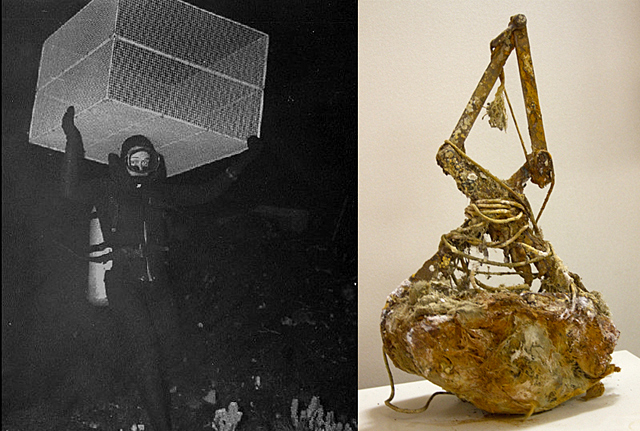Historical artifactDivers recover piece of lost experiment from 'dawn' of research in McMurdo SoundPosted December 24, 2010
An artifact from the “dawn” of biological research in McMurdo Sound has been recovered from the seafloor and turned over to the Albert P. Crary Science and Engineering Research Center at McMurdo Station A team of research divers revisiting decades-old experiments that consisted of cages and other artificial structures — home now to all manner of marine organisms — retrieved the coral-encrusted “benthic grab” in October from the frigid waters beneath the sea ice. A benthic grab is a heavy instrument that does pretty much what its name implies: Once dropped to the bottom, it bites into the seafloor and then brings up a sample of organisms that live on or just below the bed. The particular instrument was first used by John Dearborn in 1958 during the International Geophysical Year “Historically, this grab was the most important single instrument for seafloor ecology in McMurdo Sound,” wrote Paul Dayton The so-called lost experiments revisited by the research divers had been set up by Dayton and his colleagues during those previous decades. He returned to McMurdo Station this season for the first time in 20 years as a co-principal investigator on a project to track the changes in the seafloor ecosystem. John Oliver The benthic grab was lost in 1961, and it remained on the bottom of McMurdo Sound until anchor ice (ice attached to the ground) lifted off the seafloor and stuck into the bottom of the floating sea ice above. That’s where Dayton found it in 1967. He used its weight to demonstrate the lifting power of anchor ice, and published the results form the experiment in a 1969 Science paper. He used it for several other experiments, eventually abandoning it in 1974 as a weight to sink another experiment. “Of course, I now regret that abuse of such an historic artifact, and we retrieved it a couple weeks ago, encrusted but in remarkable shape,” Dayton said in an e-mail in late October. The 69-year-old professor said both Dearborn and Pearse agreed that the artifact should remain at McMurdo Station. The instrument’s value lies not in just its age, Dayton noted. He said Dearborn’s work relied heavily on its use from 1958-61. The research was the “most comprehensive bottom survey of any deep-water habitat in the world. [Dearborn] has fond memories of hauling the icy rope in the dark, in temperatures to 50 below.” Dearborn, 77, died shortly after learning about the recovery of his key piece of equipment, on Nov. 22, 2010. He was an emeritus professor of marine sciences at the University of Maine, where he had worked from 1966-99. Cara Sucher, manager of the Crary Lab, said she plans to build or purchase a pedestal to display the benthic grabber in the building’s main hallway. Dayton offered to clean up the crusty instrument — about the size of a small boat anchor — but Sucher argued it was perfect just the way it was found – crust, rope and all. “It’s kind of a neat history of the thing,” she said.
|



For USAP Participants |
For The Public |
For Researchers and EducatorsContact UsU.S. National Science FoundationOffice of Polar Programs Geosciences Directorate 2415 Eisenhower Avenue, Suite W7100 Alexandria, VA 22314 Sign up for the NSF Office of Polar Programs newsletter and events. Feedback Form |



